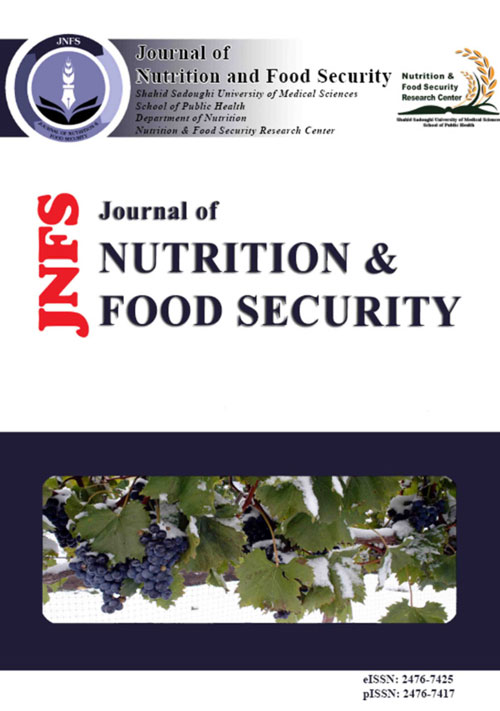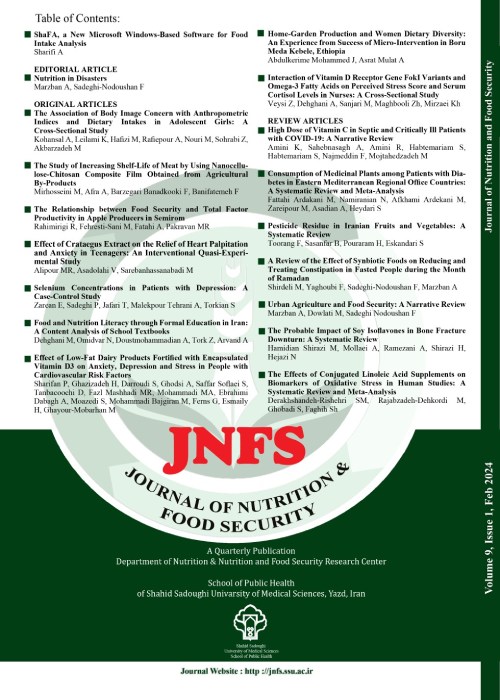فهرست مطالب

Journal of Nutrition and Food Security
Volume:2 Issue: 1, Feb 2017
- تاریخ انتشار: 1395/11/23
- تعداد عناوین: 8
-
Pages 81-83
-
Pages 87-95BackgroundPreliminary clinical trials showed that ginger improved lipid profile in type 2 diabetes patients (T2D). This trial was carried out to determine the effect of ginger on blood lipid and lipoproteins in T2D.Methodsthis is a randomized, double-blind, placebo-controlled trial on 88 T2D conducted in. The patients were randomly divided into two groups of ginger (GG) and placebo (PG), the GG consumed daily 3 one-gram capsules containing ginger powder whereas the other group received capsules of the same color and number as GG but containing cellulose microcrystalline, both after taking meals and for eight weeks. Serum total cholesterol (TC), triglycerides (TG), HDL-c, LDL-c, Apo B100 and Apo A1 were measured at the baseline and the end of trial.ResultsOut of 88 patients who participated in the trial, 81 of them accomplished it. No significant changes were observed in mean of TC, TG, HDL-c, and Apo B100 within and between the groups. Serum LDL-c and LDL-c/HDL-c ratio were decreased significantly in the GG (P = 0.03, P = 0.028) at the end of trail but they were not significantly different between the two groups. Serum Apo A1 was increased significantly in the GG (PConclusionsThis study indicated that daily consumption of 3 g of ginger powder in capsules for 8 weeks by T2D leads to lowering of LDL-c, LDL-c/HDL-c ratio, and Apo A1. Therefore, consumption of this supplementation is appropriate for this patientsKeywords: Ginger, Diabetes Mellitus, Blood Lipids, Lipoproteins
-
Pages 97-104BackgroundPrevious researches reported inconclusive findings on the interaction of Helicobacter pylori (H.pylori) infection with body indices, although, most of these studies used body mass index (BMI) to assess such an association. The aim of this study was to investigate the association of H.pylori seropositivity with anthropometric indices as well as blood pressure (BP) among a group of young population in Zahedan, a city in south-east of Iran.MethodsA total of 363 undergraduate students participated in this cross-sectional study, in 2014. Serum IgG antibodies against H.pylori were measured and the cut-off level of antibody titers more than or equal to 20 was considered as H.pylori positive. Anthropometric indices and BP were measured using standard protocols.ResultsData analysis indicated that H.pylori seropositivity was equal to 45.7% . H.pylori positive participants had significantly lower mean values of BMI (P = 0.01), waist circumference (WC), and waist to height ratio (WHtR) which was marginally significant (P = 0.05) compared to H.pylori negative participants. No significant differences were found in waist to hip ratio (WHpR), as well as systolic blood pressure (SBP) and diastolic blood pressure (DBP) between the two groups. Although, after adjustment for confounding factors, higher values of BMI (OR = 1.12, 95% CI = 1.003-3.2) and WHtR (OR = 1.04, 95% CI = 1.001-2.71) were positively correlated with higher odds of H.pylori positivity.ConclusionsH.pylori positivity was correlated with higher BMI and WHtR after adjusting for other variables, but no correlation was observed for WC, WHpR, or BP among a group of young undergraduate students in south-east of Iran.Keywords: Helicobacter pylori, Anthropometric indices, Blood pressure, Young population, Iran
-
Pages 105-111BackgroundObesity is one of the major health problems in the world; in this regard Iran is not an exception. The present study was conducted to investigate the overweight, obesity, and its related factors in adult women who referred to health centers in Shiraz, Iran.MethodsIn this cross-sectional study, 240 women who referred to health centers and aged 18-65 years old were selected through multi-stage random sampling, in 2013-2014. Height, weight, as well as waist and hip circumferences were measured, participant's body mass index (BMI) and waist to hip ratio (WHR) were also calculated. The questionnaire of demographic factors, physical activity, and food frequency were completed.ResultsThe prevalence of overweight and obesity based on BMI was 29.2% and 13.8%, respectively. The mean of WHR was 0.89 ± 0.06 and based on this index, 79.2% of the participants had visceral obesity. There was a direct correlation between BMI and age, number of children, labor, energy, and fat intake. However, the correlation between BMI and physical activity, age of marriage, and protein intake was inverse (PConclusionsGenerally, despite extensive programs of public education, there is an alarming prevalence rate of both generalized as well as central overweight and obesity in the present study.Keywords: Overweight, Obesity, Women, Shiraz
-
Pages 113-116BackgroundOne of the most critical problems in the field of water and food pollution is the heavy metal pollution. Agricultural products are exposed to this type of contamination through wastewater; industrial activity and population pollutions are also in its area. Since the plant in the affected areas can directly enter heavy metals into the food chain, so, it is important to check their level of contamination. The purpose of this study was to monitor distribution of copper and nickel in the grape cultured in the farms around Marvast in Yazd province.MethodsAll chemicals were of analytical grade. In order to determine the level of copper and nickel in grape extracts produced from the most important areas in grape production, 7 samples of grape were taken from these geographic regions. After grinding and homogenizing of samples, the concentration of nickel and copper, heavy metals were measured by atomic absorption spectrometer. The obtained results were analyzed through SPSS software based on statistical methods.ResultsThe mean value of copper and nickel were 26.4 ± 3.1 and 12.3 ± 1.5 μg/kg, respectively. According to the obtained results and their comparison with standards, different amounts of copper and nickel were observed in all samples, however, the highest amount of these metals was observed in one sample.ConclusionsConcentrations of heavy metals in samples from different regions were lower than the maximum allowable concentration of copper and nickel. Although, the amount of these metals in one sample, known as pollution indicator, suggested that this area can be exposed to both.Keywords: Copper, Nickel, Grape, Marvast city
-
Pages 117-125BackgroundHealth benefits of vitamin D has been proved by a large number of studies, however, to the best of our knowledge there has been no study investigating the effect of mega dose of vitamin D on gestational diabetes mellitus (GDM). This study was the first to assess the effect of postpartum injection of mega dose of vitamin D on blood pressure (BP) in GDM.MethodsThis is a randomized controlled clinical trial conducted on 58 pregnant women suffering from GDM who were randomly assigned into control (CG, n = 24) and intervention group (IG, n = 24). Patients in intervention group (IG) received an intramuscular injection of 300,000 IU of vitamin D. BP, Serum concentration of 25 (OH) D3, parathyroid hormone (PTH), calcium, phosphor, diastolic (DBP) and systolic blood pressure (SBP) were measured at the baseline and after 3 months.ResultsMega dose supplementation resulted in increased serum 25-hydroxy vitamin D concentrations in IG compared with the CG (62.10 nmol/l compared with 24.10 nmol/l, PConclusionsThis study strongly improved vitamin D status in women with GDM and consequently confirmed the efficacy of a mega dose of vitamin D injection on decreasing of BP.Keywords: Gestational Diabetes Mellitus, Blood Pressure, Vitamin D
-
Pages 127-134BackgroundCeliac disease (CD), as an autoimmune disease has initiated since ingestion of food containing gluten. Constant intolerance to gluten causes damages of the small intestinal mucosa. One reason of mal-absorption in children and infants is CD. Additionally, about 75% of newly identified patients with CD have low bone mineral density (BMD). Many factors have role in metabolic bone diseases, such as disturbance in calcium absorption, consumption of endogenous calcium, fecal loss, damaged to vitamin D absorption, and inflammatory mediators. The gluten free diet (GFD) is the only efficacious treatment for CD. Low BMD which is a prevalent problem of untreated CD may be restored by GFD.MethodsDatabases of PubMed, Web of science, Google scholar, Scopus and Embase were searched by the following keywords: CD and GFD, CD and BMD, GFD and children up to July 2016.ResultsMost children with CD already have reduced bone mass density before treatment with GFD. GFD caused normal bone mineral density in most of celiac children and adolescent. The treatment duration for restoration of bone mass was not obvious. There were no similar time points for all patients, thus the duration of treatment was different. There was a relationship between age of patients at diagnosis and therapeutic intervention and recovery of BMD; older children may have slower grades of improvement.ConclusionsGFD has an important role in bone health. If CD is diagnosed and managed before adolescence, children with CD may achieve normal bone mass.Keywords: Celiac, Gluten free diet, Bone mineral density


